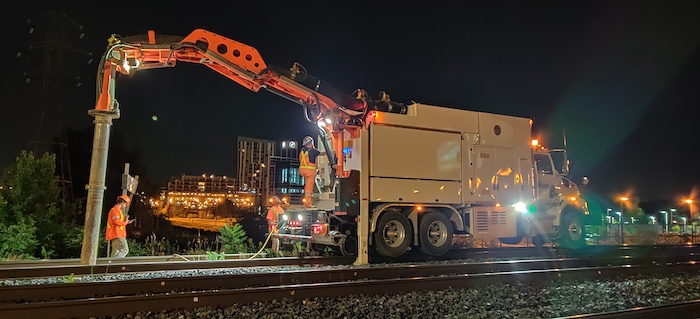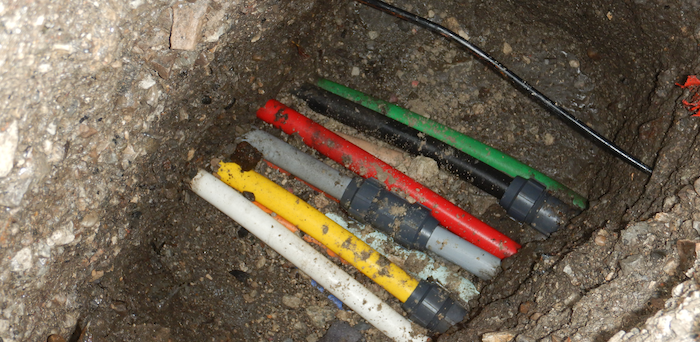
The importance of subsurface utility engineering
January 27, 2021
By Scott Gaudun
Investigations help keep projects on time and budget.
Sometimes, it seems any construction project in a developed area—be it city, town or village—has to contend with a maze of underground utilities. There are water lines, sanitary sewers, storm drains, telecommunications cables and electrical conductors—and in many cases, these installations are not where the site plans say they are supposed to be. This can result in project delays, increased cost and the possibility of legal action if any damage is done.
“The extent of an investigation will depend on the kind of information needed.”
To address this issue, subsurface utility engineering (SUE) is an evolving branch of the consulting engineering community that determines the exact locations of underground structures for a planned construction site, using both existing records and new on-site verification tools. SUE is quickly becoming an essential part of planning projects and keeping them on time and on budget.
SUE involves four levels of investigation, A through D. The extent of a given investigation will depend on the kind of information that is needed.
Level D
The simplest level of investigation involves gathering the existing information about the site, in what might be called a desktop study.
This information would include a topographical survey, maps and plans from various utilities, compiled into a unified document. It is rarely straightforward, however, given the many utilities that may have infrastructure on-site, ranging from traffic signal cabling to sanitary sewers.
While a Level D investigation can provide a good foundation of knowledge, utilities are rarely all listed on the available documents and the accuracy of records is usually inconsistent. The underground reality may be very different from what is shown on the plans.
Level C
The next level of investigation involves on-site surveying from the surface, noting the locations of such clues as access covers for sewers, pedestals and hand valves. Survey crews use a combination of technologies—with the specific tools depending on the site and the time of the work—to verify the information provided in plans to as high a degree as they can from the surface.
It is quite common for the information gathered in Level C to conflict with that from Level D. Further investigation is often needed.
Level B
The next level involves more in-depth site investigation to connect to utilities and verify their locations. Using a site plan developed through levels D and C, the SUE team does whatever is possible without digging.
Some pipes made of ferrous metals, for example, can be located through electromagnetic resonance, while gas lines and other pipelines not made of ferrous metals may be located by connecting a light electrical current to their tracer cables, so long as those cables are still intact.
Also, at Level B, sewer access covers can be opened and tape measures, fixed rods and range finders can be used to get a sense of the depth of a given utility. The SUE team can use a variety of technologies to record chamber details and the invert and size information for connected features.
Level A
For many projects, investigations at Levels D, C and B are sufficient. In the case of conflicts or where two utilities cross each other, however, it is important to collect greater details through a Level A investigation, which involves verifying by digging, to physically locate utilities.
When engineers need to determine the depths of utilities, there is often only limited information available through Level D, C and B investigations. Indeed, a Level A investigation is often a means of clearing up mysteries and avoiding unpleasant surprises by digging deeper.
SUE engineers can use non-destructive methods, such as a vacuum excavator, for test pits. Then, using pressurized air and water, the location of a utility can be verified safely. Known as daylighting, this is sometimes the only way to get an accurate picture.
“The accuracy of records is usually inconsistent.”
An experienced team
As a discipline, SUE has been coming into its own in the past two or three decades, driven by a increased focus on safety, as well as an increased density of infrastructure in the underground environment.
A SUE firm needs significant experience in the field. While the concept of the investigations may seem simple, the reality on (and under) the ground can be much more complex. It takes time to learn how to combine plans from a wide range of utility owners, to know what to expect about the utilities’ locations and to find effective workarounds when details are difficult to uncover.
It is not just a matter of going through the required steps, but of seeking the best possible answers to the questions at hand, so a project workflow can be planned accordingly. Depending on the specific client’s needs, the SUE team can prepare a ‘draft’ or interim document setting out the compiled information and pointing out areas where further investigation (e.g. test pits) is needed. Then, a review process can collect the client’s comments, corrections and further questions, so subsequent reports can address any remaining issues.
To get full value from SUE’s planning benefits, clients should receive a comprehensive report covering everything needed in their investigation boundaries. This is why finding the right firm as a SUE partner can help ensure projects are completed on budget and on time.
Scott Gaudun is manager of SUE services for Planview Utility Services, a division of OEC, based in Markham Ont.

